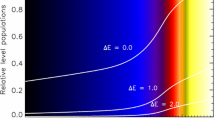Summary.
This review is primarily directed to the question whether photometric solar analogues remain such when subjected to detailed spectroscopic analyses and interpreted with the help of internal stucture models. In other words, whether the physical parameters: mass, chemical composition, age (determining effective temperature and luminosity), chromospheric activity, equatorial rotation, lithium abundance, velocity fields etc., we derive from the spectral analysis of a photometric solar analogue, are really close to those of the Sun. We start from 109 photometric solar analogues extracted from different authors. The stars selected had to satisfy three conditions: i) their colour index \((B-V)\) must be contained in the interval: \(\Delta (B-V) = 0.59\)–0.69, ii) they must possess a trigonometric parallax, iii) they must have undergone a high resolution detailed spectroscopic analysis. First, this review presents photometric and spectrophotometric researches on solar analogues and recalls the pionneering work on these stars by the late Johannes Hardorp. After a brief discussion on low and high resolution spectroscopic researches, a comparison is made between effective temperatures as obtained, directly, from detailed spectral analyses and those obtained, indirectly, from different photometric relations. An interesting point in this review is the discussion on the tantalilizing value of the \((B-V)_\odot\) of the Sun, and the presentation of a new reliable value of this index. A short restatement of the kinematic properties of the sample of solar analogues is also made. And, finally, the observational \((\log T_{\rm eff}, M_{\rm bol})\) diagram, obtained with 99 of the initially presented 109 analogues, is compared to a theoretical \((\log T_{\rm eff}, M_{\rm bol})\) diagram. This latter has been constructed with a grid of internal structure models for which, (very important for this investigation), the Sun was used as gauge. In analysing the position, with respect to the Sun, of each star we hoped to find a certain number of stars tightly neighbouring the Sun in mass, chemical composition and state of evolution. The surprising result is that the stars occupy in this HR Diagram a rather extended region around the Sun, many of them seem more evolved and older than the Sun, and only 4 of the evolved stars seem younger. The age of some stars in the sample is also discussed in terms of chromospheric activity and Li-content. Our conclusion is much the same as that contained in previous papers we have written on the subject: in spite of a much larger number of stars, we have not been able to nominate a single star of the sample for a “perfect good solar twin”. Another aim in beginning, 25 years ago, this search for solar analogues, was to have ready a bunch of stars resembling the Sun and analysed spectroscopically in detail, in order that, when planets hunters of solar type stars, finally would have found such a specimen, we would have been able to immediately compare the physical parameters of this star to those of the Sun. We have been lucky enough: one of the good solar analogues we present herewith, is 51 Pegasi (HD 217014) which, according to the very recent observations by Mayor and Queloz (1995), has a planet orbiting around it. And what is more: two other stars possessing planets: 47 Ursae Majoris (HD 95128) and 70 Virginis (HD 117176), have just been discovered by Marcy and Butler (187\(^{\rm th}\) Meeting of the AAS, January 1996). One of them, 47 Ursae Majoris, is also included in the list of photometric solar analogues. The other star, 70 Virginis, has only been included after the “Planets News”, because the colour index \((B-V)\) of this star is slightly higher than the prescribted limit of the selection, (\(B-V = 0.71\), instead, 0.69). It would have been a pity to leave the third ” planet star out of the competition.
Similar content being viewed by others
Author information
Authors and Affiliations
Rights and permissions
About this article
Cite this article
Cayrel de Strobel, G. Stars resembling the Sun . The Astron Astrophys Rev 7, 243–288 (1996). https://doi.org/10.1007/s001590050006
Issue Date:
DOI: https://doi.org/10.1007/s001590050006




